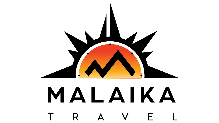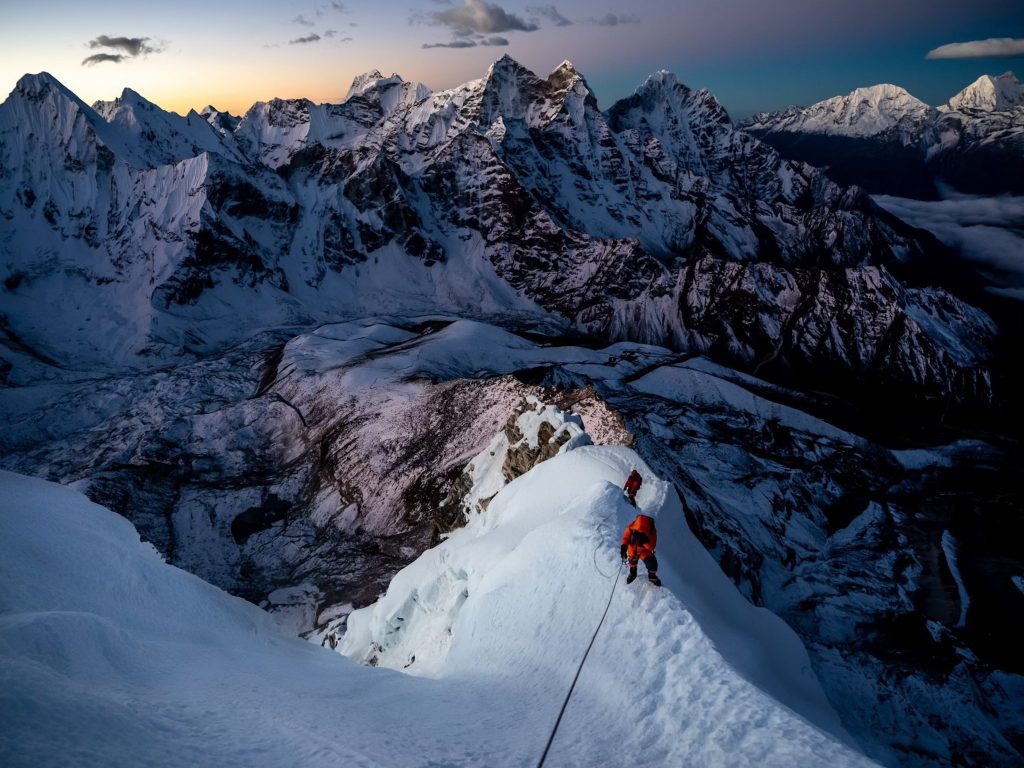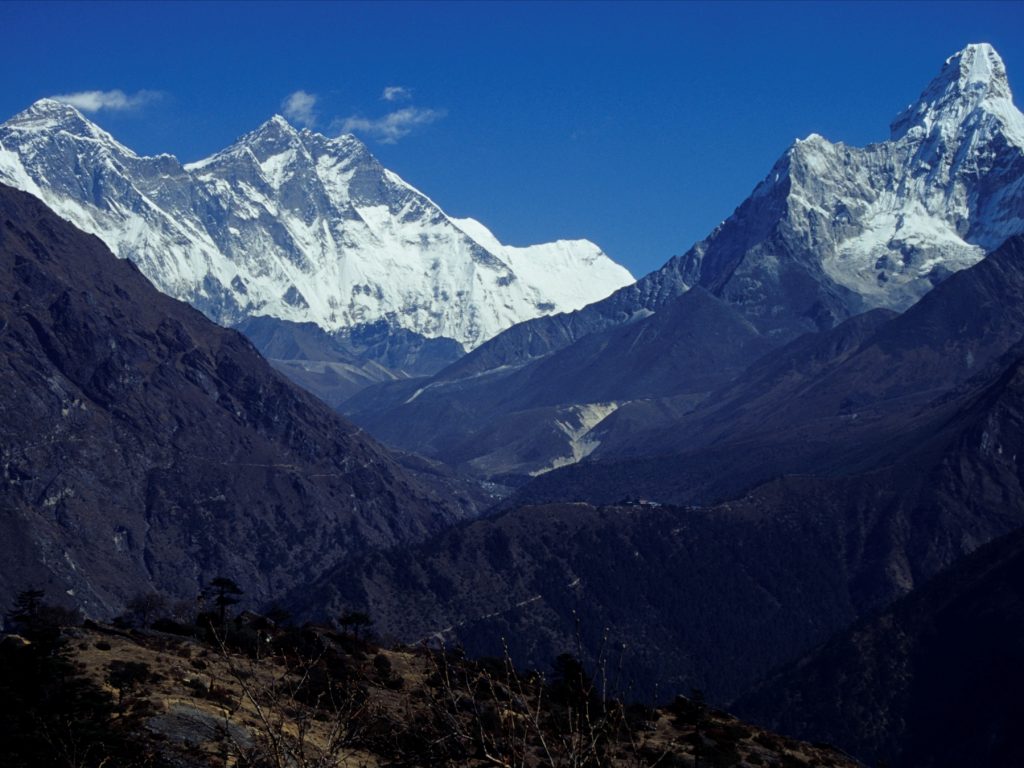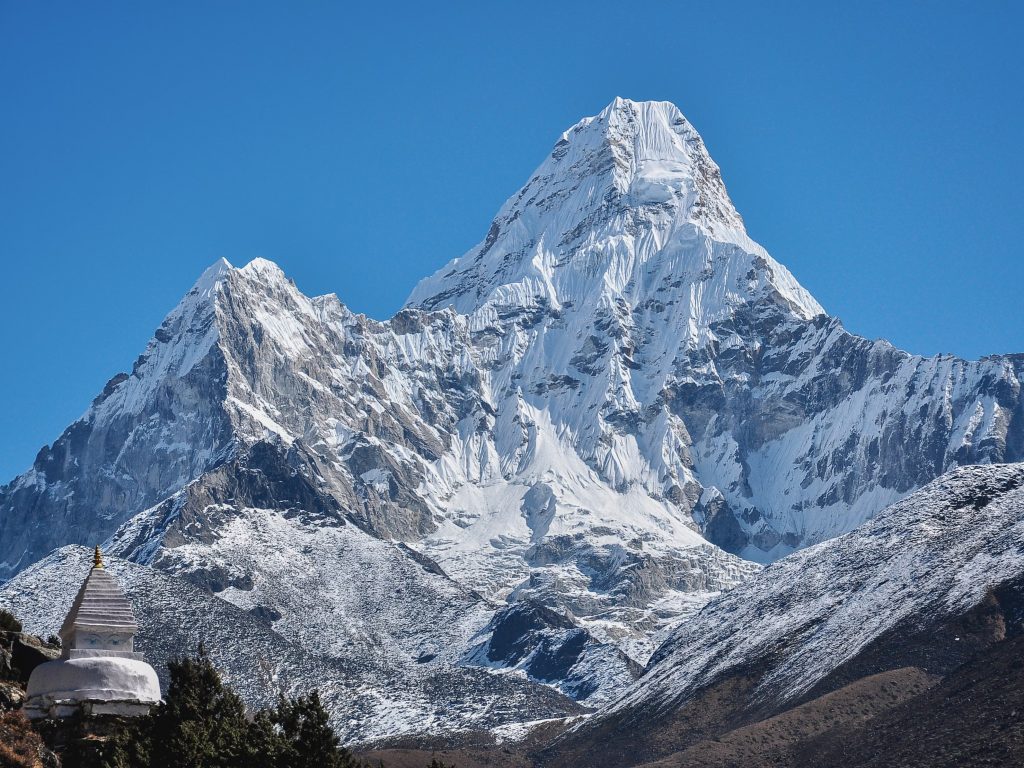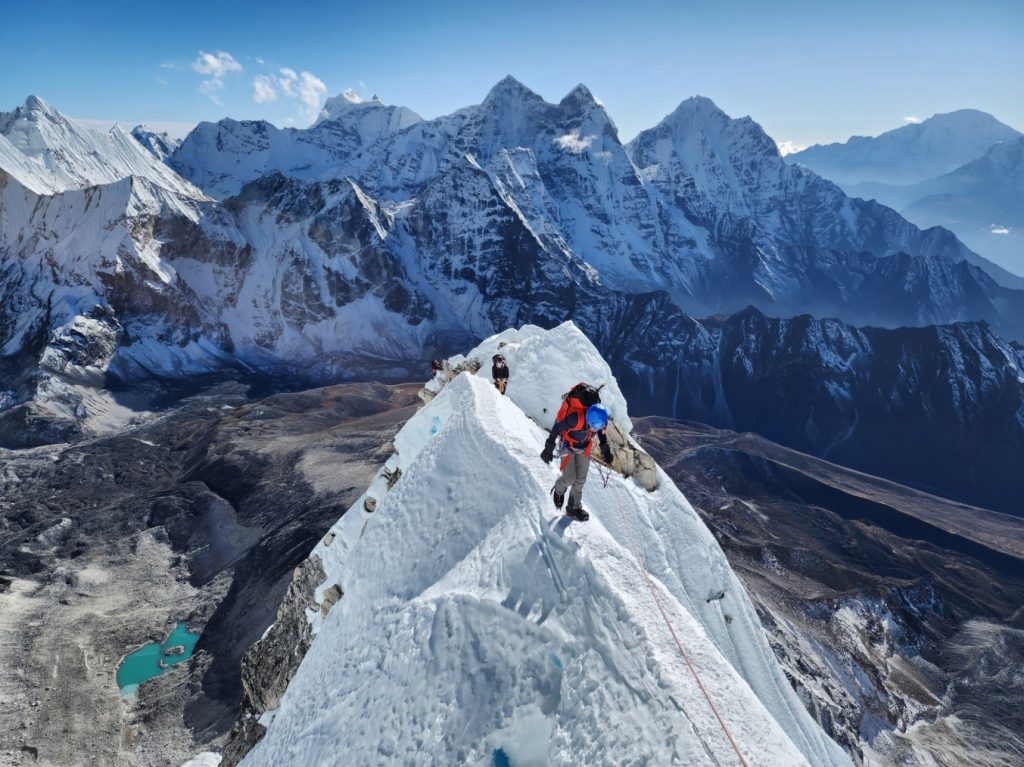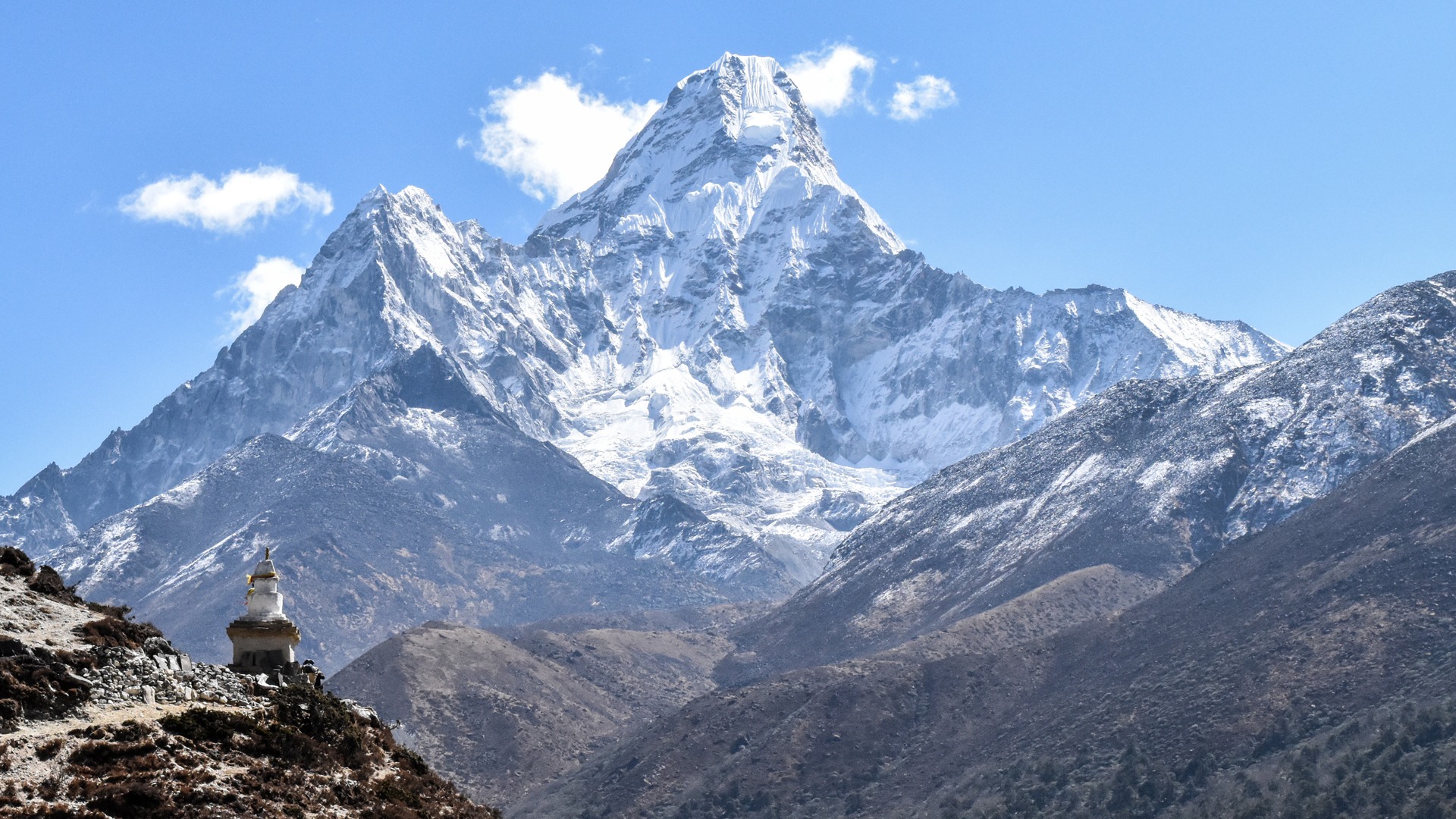
Ama Dablam Expedition
Ama Dablam Expedition
Overview
Ama Dablam is a stunning mountain in the Himalayas, often considered one of the most beautiful and challenging peaks in the world. It has a distinctive shape, resembling a mother’s necklace (ama) and a small pendant (dablam). The standard route to climb Ama Dablam is the South West Ridge, which involves technical rock, ice, and snow climbing, as well as exposed and corniced ridges. The summit offers spectacular views of Everest, Lhotse, Makalu, and other giants of the Himalaya.
Day to day itinerary
Day 1: Arrive in Kathmandu and go to your hotel (1300m)
You’ll arrive at Kathmandu Tribhuvan International Airport and will be greeted by our staff with a warm welcome and then you’ll be transferred to your respective hotels. After, you’ll have a briefing regarding the Ama Dablam Expedition. Overnight you’ll stay at the hotel.
Day 2: Trip briefing, paper works and gear checking
After breakfast, we might wander around the nearby area and do some shopping for our trip the following day. In the afternoon, we will visit the office for a pre-trip discussion and meet our trekking guide as well as the other participants. You will also be briefed on the expedition, equipment and team composition. Overnight you’ll stay at the hotel.
Day 3: Fly from Kathmandu to Lukla(2840m) Overnight stay at Phakding (2610m) [3-4 hrs]
Early in the morning, you will be picked up at the hotel by our guide and they’ll escort you to the domestic terminal of Kathmandu airport. Then you’ll board the flight from Kathmandu to Lukla. During the 30 minutes, you can enjoy the stunning views of the Himalayas. After landing at the Tenzing-Hilary airport, you will meet your porter. He will carry your luggage. Then, you’ll start your trekking. Today you will trek for three hours. It’s easy and gentle. The trail starts by passing a Kani (a ceremonial gatehouse). It descends steeply, and then runs above Kyangma village, which has a large gompa (monastery) and school. After that, you’ll enter Cheplung village. The trail descends through the community forest and you can see Dudh Koshi River. Crossing the suspension bridge is a short climb around the ridge to Ghat. After leaving Ghat, the trail passes around a school and a complex of mani walls, Chortens and prayer wheels. Then, the trail climbs to the hamlet of Chhuthawa. After a short walk from Chhuthawa, you’ll reach Phakding. Overnight you will stay at a lodge. Breakfast, lunch & dinner are included.
Day 4: Phakdingto trek to Namche Bazaar (3440m) [6-7 hrs]
After a nice morning, the walk continues. You will be crossing bridges over Dudh Kosi River and passing several interesting villages like Tok-Tok, Bhenkar and Monjo before arriving at the Sagarmatha National Park entrance gate. From here, we’ll walk on the river bed for a few hours and after the last bridge there’ll be a steep ascent to Namche Bazaar, where there are good restaurants, pubs, a cyber café, a post office, and banks. Overnight you will stay at a lodge. Breakfast, lunch & dinner are included.
Day 5: Namche Bazaar rest day for acclimatization
This is the first of the two days set aside for acclimatization. Health experts recommend staying active and moving during the rest day instead of being idle. We’ll either spend the day hiking to Thame, visiting Khunde, or relaxing and exploring Namche Bazaar itself. Namche Bazaar is the main center of the Everest (Khumbu) region and it has government offices, ATMs, internet cafes, shops, restaurants, a bakery, and a colorful market every Friday evening and Saturday. If we trek a few hundred feet during the day, it will help us to properly acclimatize. Our guides will take us to the Tourist Visitor Center near the headquarter of the Sagarmatha National Park where we can observe an assortment of things related to the first Everest climbers, Sherpa culture and the various plant and animal life of the Everest region. Overnight you’ll stay at a lodge. Breakfast, lunch & dinner are included.
Day 6: Namche Bazaar to Tyangboche(3860m) [5-6 hrs]
The trek continues alongside the rushing glacial waters of the Dudh Kosi with magnificent views of the mountains. We’ll have trekked to an altitude of 3,860 m once we reach Tengboche. Inside the monastery are incredibly ornate wall hangings, a 20-foot sculpture of Buddha, and the musical instruments and robes of the Lamas. You will be taken to observe a prayer ceremony either in the evening or in the morning depending on how the trekking goes on this day. Overnight you’ll stay at a lodge. Breakfast, lunch & dinner are included.
Day 7: Trek to Pangboche (3900m) [2 hrs]
From Thyangboche, the trail goes down to Debuche, crosses a suspension bridge on the Imja Khola, and climbs to Pangboche amongst thousands of mani stones. Overnight you will stay at a lodge. Breakfast, lunch, and dinner are included.
Day 8: Trek to Ama Dablam base camp (4600m) [5-6 hrs]
We’ll trek back down the trail to the bridge at Pangboche and cross the Dudh Kosi before climbing up the along far side of the river and following the trail and ridgeline up to the base camp (three and a half hours from Pangboche). The base camp is located in an idyllic spot from which the majority of the route is visible. At an altitude of about 4600m (15,000ft), it provides a comfortable escape from the climb. Our porters drop off their loads and leave us here for the next three weeks with only our Sherpas and culinary staff. Overnight, you’ll stay at tented camp. Breakfast, lunch, and dinner are included.
Day 9: Base Camp preparation; rest day
Today is another day for acclimatisation.
Day 10 to Day 26: Climbing period (summit Ama Dablam 6812m)
We do not provide a day-to-day itinerary for the climbing period, as this will be determined by the expedition leader and members. The guides will take a flexible approach based on what fits with the climbers and their experience. Typically, the team will spend a few days at the base camp organizing food, practicing rope skills, and acclimatizing before leaving the base camp. It is normal to spend at least one night in Camp 1 (5700m) as part of your acclimatization schedule before returning to the base camp, resting, and preparing for the summit push. You’ll climb Ama Dablam via the southwest ridge. After leaving the base camp, you’ll go eastwards to a broad saddle 5150m from where we can see the Mingbo La. From the saddle, we’ll ascend northwards until the ground steepens and you reach a boulder field. We may place an advanced base camp at 5400m below the boulder field. The route continues north around the base of the boulder field, and then follows cairns upward to the toe of the southwest ridge. After some easy scrambling on the east side of the ridge, you’ll quickly get to Camp 1. There are four or five tent platforms. From Camp 1, we’ll go around the snowy bowl until we are below two rock fingers. You’ll follow the east side of the ridge, climbing easy mixed ground. The ridge is narrow in places, with difficult turns on the east side. The route continues on the crest of the ridge for a short distance until we are forced onto the west side of the ridge. Next, you’ll traverse the east face of the ridge crest. This 15-meter pitch, just below Camp 2, is one of the hardest pitches on the climb at HVS (5.8) standard. A short section of ridges then leads to Camp 2 (5900m). Camp 2 has very limited tent space (three or four tent platforms) and it is extremely exposed. It is sometimes only used to store equipment, with expeditions choosing to go from Camp 1 to Camp 3 in a single push. From Camp 2, the climb skirts a red rock bluff on the east and after a step down; it follows the snow ridge directly to a tricky traverse on the east. This leads to a gully between the Grey Tower and the lower rock buttress. We climb the gully until a very exposed traverse line is reached on the west side of the ridge. A short snow slope is ascended, allowing us to reach the start of the Mushroom Ridge. Following this typically involves some steep snow sections, until Camp 3 (6300m) is reached. The route climbs the snow and ice slope directly above Camp 3 and to the right-hand side of Dablam. We continue to cross Dablam on the right, and then we move west to a small snowfield below the Bergschrund. You cross the Bergschrund and then the climb heads directly to the ice crest above. This is followed by a magnificent climb to the summit. (high quality camping tents will be provided in each camp) Overnight you’ll stay at a tented camp. Breakfast, lunch, and dinner are included).
Day 27: Trek back to Namche Bazaar (3440m) [6-7 hrs]
We’ll descend for six to seven hours to Namche Bazaar (3440m). If we are lucky, we’ll arrive on time for the markets in Namche. Regardless, there is always fabulous food to be found, including delicious espresso, yak steaks, and chocolate cake with frosting! This market is where lowland porters bearing supplies meet the highland Sherpas and Tibetan people who have journeyed over high passes from many miles away to trade food and supplies for their houses and villages. You can enjoy and celebrate your expedition. Overnight you’ll stay at a lodge. Breakfast, lunch, and dinner are included.
Day 28: Trek to Lukla (2800m) [7-8 hrs]
We’ll return to Lukla (2800m), where the trip began, after a 7-8 hour trek. We’ll take time to reflect on the trek as a group, and the personal achievements of all who took part. You’ll also have plenty of time to explore the town. Overnight you’ll stay at a guesthouse. Breakfast, lunch, and dinner are included.
Day 29: Morning flight back to Kathmandu
We’ll catch an early morning flight to Kathmandu after our long journey. After reaching Kathmandu, we can take a rest or do some souvenir shopping. If we want to explore any other areas of Kathmandu, we can do that today. Our guides can help you with souvenir shopping and sightseeing. There will be a farewell dinner in the evening to celebrate. Overnight you will stay at a hotel. Breakfast included.
Day 30: Transfer to Tribhuwan International Airport
Your adventure in Nepal comes to an end today! There is nothing left to do but trade emails with your travel companions and organize your photos. A representative will take you to the airport approximately 3 hours before your scheduled flight. On your way home, you’ll have plenty of time to plan your next adventure in the wonderful country of Nepal. Breakfast included.
US$ 9100
per personGet in touch by phone | WhatsApp | email with your preferred dates for your trip
or
Fill in the enquiry form below
Also in Nepal
Everest Base Camp Trekking
Everest Base Camp with Island Peak Climbing
Everest Base Camp with Gokyo Ri Trekking
Everest Base Camp with Gokyo Ri Trekking & Lobuche Peak Climbing
Everest Base Camp 3 High Passes Trekking
Everest Base Camp with Helicopter Fly Back
Annapurna Circuit Trekking
Bardia Tour
Chitwan Tour
Chitwan & Badia Safari
Gokyo Valley Trekking
Island Peak Expedition
Jiri to Everest Base Camp Trekking
Langtang Valley Trekking
Langtang Gosaikunda & Helambu Trekking
Manaslu Trekking
Manaslu Tsum Valley Trekking
Mardi Himal Trekking
Mera Peak Expedition
Mera, Island Peak, Lobuche Peak with EBC Trekking
Mera, Island Peak with EBC & Gokyo Ri Trekking
Poon Hill Trekking
Poon Hill with Annapurna Base Camp Trekking
Salleri to Everest Base Camp Trekking
Salleri to EBC Trekking with 3 High Passes
Upper Mustang Trekking
Bhutan
Bhutan Tour
Gallery
Included in the price
Not included in the price
Equipment
Travel documents
- Valid passport
- Credit cards
- Passport size photo (4 photos)
- Insurance paper and a contact address
- Family members’/company’s contact address
Footwear
- Kailas / Lasportiva / Millet (summit shoes)
- Normal socks (5-6 pairs)
- Summit socks (2 pairs)
- Trekking shoes (1 pair)
- Camp booties (1 pair)
- Basecamp slippers (1 pair
Upper body
- Lightweight top / thermo coat (2-3 layers)
- Mid weight top (2-3 layers)
- Heavyweight top (2 layers)
- Fleece jacket (1)
- Gore Tex jacket (1)
- Down jacket (1)
- Wind proof jacket
- Cotton T-Shirt for the base camp. (2-3)
Lower body
- Lightweight long underpants (2-3 pairs)
- Underwear (5-7 pairs)
- Mid weight long underpants (2-3 pairs)
- Heavyweight long underwear
- Gore Tex pants (1)
- Down pants (1)
- Waterproof pants (1)
Head
- Sun cap
- Desert cap
- Balaclava
- Fleece hat
- Neck gaiter (2-3)
Hands
- Thin fleece gloves (2 pairs)
- Wind stopping fleece gloves
- Heavy gloves (mittens)
- Summit gloves
Sleeping
- Sleeping bags
- Sleeping bag – 20 degrees Celsius (for base camp)
- Down sleeping bag – 20 To -40 degrees Celsius (extreme comfort)
- Thermarest mattress (cell foam)
- Thermarest mattress (inflatable)
Climbing equipment
- Climbing helmet
- Down suit (Kailas / Marmot / Mountain Hardware / North Face / Millets )
- Crampons (that fit with boots)
- Ice axe
- Harness
- Atc guide
- Jummer / ascender
- Lock carabiner (3)
- Unlock carabiner (3)
- Tape slings (2)
- Prusik loops (1)
- Snow goggles
- Headlight (4 pairs of rechargeable batteries recommended)
Medical and practical items
- Satellite phone
- Hand warmers (if possible)
- Backpacks
- Rucksacks 45L – 55L
- Duffel bag 90 L -120 L (2)
- Waterproof sacks large (2)
- Waterproof sacks small (2)
- Banana Boat/ Nivea sunccream -50 (SPF)
- Lip balm -20 / -50 (SPF)
- Sunglasses (UV protection)
- Glacier glasses (UV protection)
- Hand disinfectant
- Wet wipes
- Toothpaste
- Toothbrush
- Soap
- Shampoo
- Rubbish bag
- Water bottle (2)
- Thermos
- Mug
- Spoon/fork
- Bowl
- Ibuprofen
- Antibiotics
- Diamox
- Paracetamol
- Plasters
- Bandages
- Tincture iodine
- Walking stick
- Pocket knife (Swiss)
- Umbrella / rain coat
